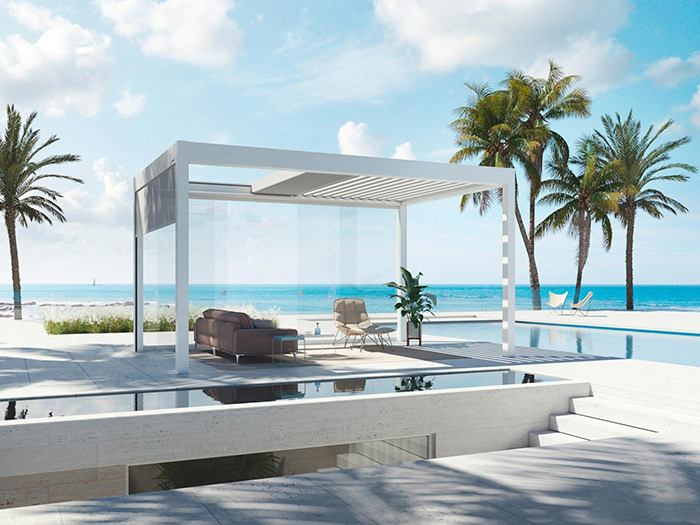Shading solutions have come a long way and moved from exposed mechanical systems to modular designs with concealed operation. They serve a range of purposes in both residential and commercial contexts. Firstly, they provide shade - and often a way to control how much light enters our houses. Secondly, they assist us with natural temperature control. And thirdly, they become a visible design feature on whatever structure they’re attached to. The days of heavy window dressings with primitive functionality are long gone. Technology has made its mark in the shading industry, and the options are astounding.
Shade Factor is at the cutting edge of shading innovation, offering innovative concealed, automated, and technology-integrated blind solutions to the commercial and domestic markets. “Our range always advances towards improving the aesthetic and sustainability qualities of modern buildings through innovation, a keen appreciation of building aesthetics and a keeping up with the evolving directions within architecture,” says Peter Skinner, Director at Shade Factor.

Shade Factor offers its own range of products, but is also the exclusive distributor and certified installer of renowned German manufacturer WAREMA, here in Australia. This combined offering enables Shade Factor to bring the latest innovations and internationally award-winning products to Australian customers. There have been many noteworthy advancements in the last few years.
“Captive fabric systems where the edge of the fabric runs in a track for increased wind resistance on external shading systems is a big one,” says Peter. “The common general market version is known as a ZIP blind, but WAREMA also offers a unique “Secudrive” version where a stainless steel ribbon is bonded to the fabric allowing the same “captive” idea to be used for large scale outdoor systems for weather protection and sun shading. The Secudrive reduces the number of moving parts resulting in longevity and high reliability. It also seals the edge of the system which means it can be built into existing shade structures and weather sealed at the edges.”

Retractable louvre roofs have also come a long way, notes Peter. These luxe additions are coveted because of their ability to be concealed within the envelope of a structure. “The louvre roof with tilting blades has been available in Australia for more than 20 years, but developing a roof that tilts and also retracts was a significant design challenge,” says Peter. “WAREMA’s retractable louvre roof system is a highly considered design as a range of different configurations exist using the complex extrusion profiles, including side screens of glass, clear retractable screens or sunscreening screens, plus integrated lighting and heating. This is a large area of growth in the shading industry. Louvre roofs can take huge wind loads so they are a clear choice for commercial applications and luxury housing in coastal (and suburban) locations.”

Concealment is also a huge, and growing, movement in the world of blinds. No longer are shading solutions seen as add-ons; rather they’re integrated into structures or the envelopes of dwellings. This can be done in a number of ways, but often it’s achieved by storing the concealed blind in a recessed part of the facade, from which it then emerges (rolls down, slides across, or extends outwards) when in use. One of Shade Factor’s specialised products; Blindspace, does exactly that. “Blindspace is a range of standard and customisable concealed boxes to accommodate blinds completely out of view,” says Peter. “It’s a “plastered in” product meaning there are no lips or overlap trims on the boxes - they’re plastered into the ceiling for a seamless appearance and are unique in this way.


He notes that for architects and designers, considering the shading solution early on is essential in order to gain its full benefit. “For concealment the most important thing is to accommodate the solution in the early design stage, as the recessed boxes need to be planned together with the structure,” says Peter. “We’re able to provide boxes only, or solutions complete with blinds.”
While the touch of technology can undoubtedly be felt right across the blind industry, nowhere is it as prominent as in the field of blind control. Automation and smart connections have revolutionised how blinds operate, and just how much they can contribute to the comfort and usability of our architecture. “At the simple end of the spectrum, our automated systems have timers and monitor sun, rain and wind,” says Peter. “These are typically for houses. They keep the shading system safe from damage in wind and rain, and keep the house cool - saving on cooling costs.”
“In the mid-range they also measure humidity, inside and outside temperature, dawn and dusk light,” he continues. “These are used for houses and commercial buildings with static floor plans. They allow more complex strategies to be implemented - for example, the shading stays retracted until the morning sun warms the spaces, then it starts shading from the sun to prevent further warming. Using products such as our external venetian blinds it’s common with these types of control systems to get a 10 degree reduction in internal temperatures during summer.”
Peter says that the high-end systems calculate (rather than measure) the position of the sun, as well as measuring reflections off neighbouring buildings, though these systems are generally reserved for commercial and high-rise buildings with changing tenancy plans. “There are a lot of studies on workplace wellbeing, and these systems are designed to provide a glare free environment, solar control and enhanced ambient daylight.”

